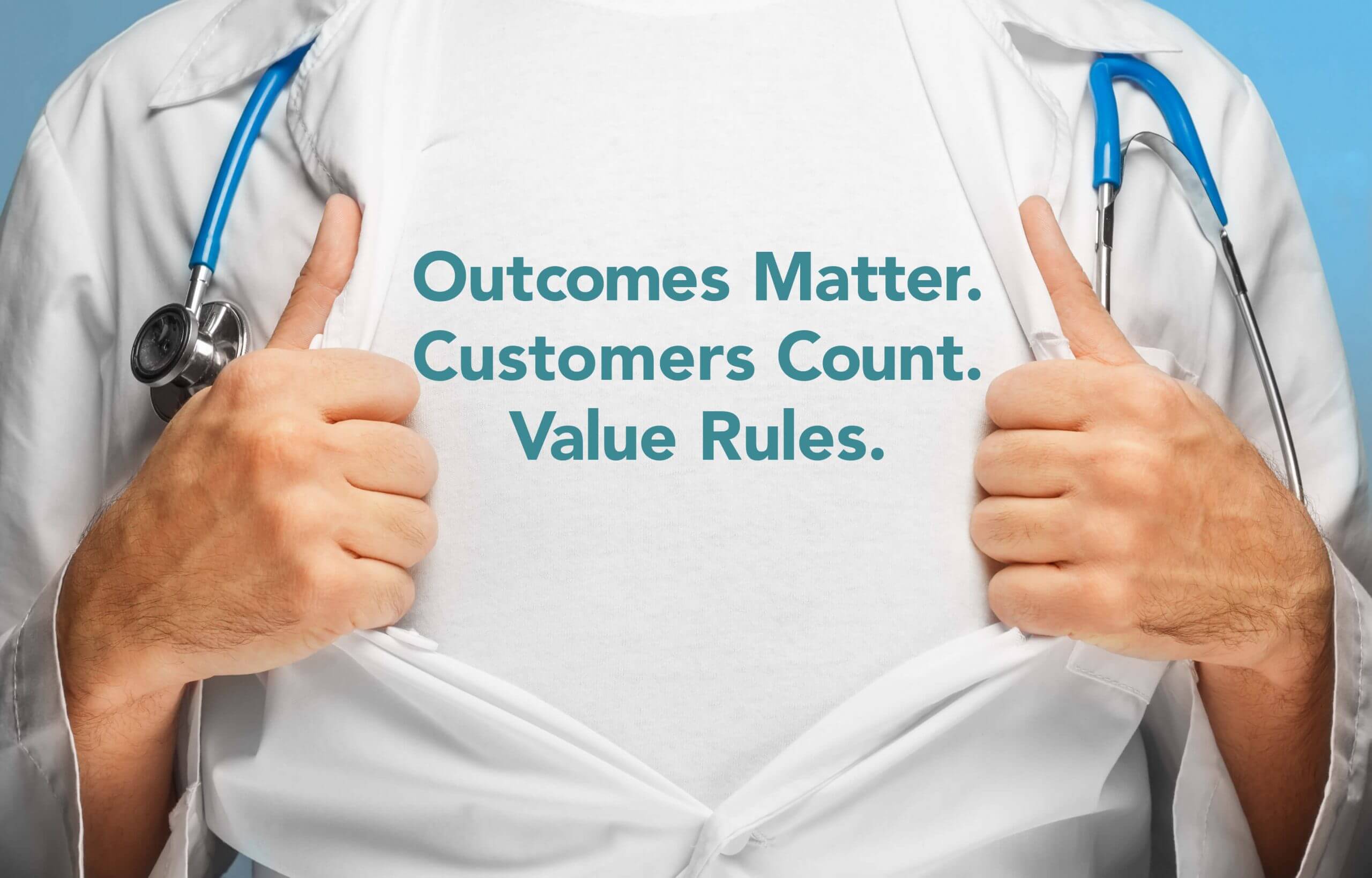May 1, 2018

Superhero Healthcare (Part 1): Liberating America’s Caregivers and Patients!
Most weekends in America, long lines form outside cineplexes as ardent fans of DC and Marvel Comics catch the latest iterations on the big screen. Since the dawn of motion pictures, Americans love to see superheroes come to the rescue – just in time.
Today, it’s American healthcare that appears on the brink of disaster. Like Gotham City, villains abound and practice dastardly deeds. Citizens wait for rescue while enduring high costs, unnecessary care and lousy service. Good battles evil every day in hospitals, clinics and doctors’ offices throughout the land. Welcome to Gotham healthcare.
Look!
Up in the sky!
It’s a bird! It’s a plane!
It’s Superhero Healthcare!
Faster than a speeding bullet and more powerful than a locomotive, market forces are transforming and improving U.S. healthcare from the ground up. They’re attacking Gotham healthcare’s fragmentation with value-based care delivery. The battle has turned in their favor. The forces of light are overcoming Gotham’s darkness.
Health companies by the thousands are reconfiguring their business models to maintain competitiveness and meet patients’ holistic needs in the post-reform marketplace.
In the process, they’re aligning economic incentives with sophisticated data analytics and technology to unleash the extraordinary talents of America’s unsung healthcare heroes. They’re turning healthcare’s Clark Kents, Lois Lanes and Jimmy Olsons into everyday Superheroes.
Patients long for coordinated, high-quality healthcare services that are personalized, convenient and affordable. They want healthcare to fix them when they’re broken and keep them as healthy as possible. They want caregivers who listen, empathize and care. These caregiver “super powers” can make all the difference.
Americans deserve healthcare that delivers superhero results everywhere, every time.
Gotham Healthcare

Since the creation of Medicare and Medicaid in 1965, health companies have operated within an artificial economy that pays providers for treatment activity, not results. Doctors and hospitals execute transactions without customers.
Patients go to providers for treatment. Providers deliver the care. Third-party payers, like Medicare and Blue Cross, reimburse providers for their services under complex “fee-for-service” (FFS) formularies. With few exceptions, FFS payments are independent of standardized protocols and quality metrics. Even today, FFS reimbursement comprises over 80% of payments to providers.
FFS payment is healthcare’s “Kryptonite” – powerful, destructive and unrelenting. It fragments care delivery, creates perverse economic incentives, distorts caregiver-patient relationships and generates sub-optimal outcomes. It costs far too much and delivers way too little.
America’s good citizens pay the consequences.
Higher health spending does not translate into superior health outcomes, just the opposite. U.S. life expectancy at birth in 2015 (78.8 years) is significantly less than life expectancy in other advanced economies (82 years).[1]
Treating chronic disease consumes over 80% of U.S. healthcare expenditure; yet, the incidence of chronic disease continues to increase. At the societal level, this translates not only into greater healthcare expenditure, but also greater inequality, lower productivity, increased social isolation and less happiness.
Improving access to healthcare services was the Affordable Care Act’s (ACA) principal policy when it became law in 2010. It worked – to a point. The percentage of Americans lacking health insurance is at its lowest level in decades.[2] At the same, Americans’ primary healthcare concern has shifted from access to cost. The American people are scared to get sick and desperate for affordable health insurance that provides the coverage they need.
It’s always darkest before the dawn. Just in time, market forces are turning the tide.
Fighting Back

It starts with a call for help.
Collectively, Americans are mad as hell and not taking it anymore. Consumers, employers and governments are fighting back against the forces of darkness by demanding greater value for their healthcare purchases.
With the explosion of high-deductible health plans, consumers are increasingly paying directly for healthcare service. With the creation of public health exchanges and increasing popularity of consumer-friendly Medicare Advantage (MA) plans, more Americans every year are comparison shopping for health insurance. They’re becoming smarter, more discerning and more demanding buyers.
Employers, tired of ever-increasing premiums, also want better alternatives for their employees. They are exploring ways to aggregate purchasing power, make health companies more accountable for outcomes, reduce unnecessary utilization and support more convenient, lower-cost treatment modalities.
In dramatic fashion, Amazon, Berkshire Hathaway and JP Morgan’s announced in January that they intend to create a new company to manage their collective healthcare expenditures. They see a “target-rich” opportunity to improve preventive care, manage treatment and reduce administrative costs. Expect more companies to follow their lead.
Even governments at all levels are experimenting with new payment vehicles, direct contracting, reference-based pricing and full-risk population health programs. They want to make it easier for individuals and companies to purchase healthcare services. They’re enacting programs and regulations that increase transparency, accountability and quality metrics. This will improve market dynamics, support innovation and reward high-value health companies.
Entrepreneurs see big, untapped opportunities. Health companies, new, old, big and small are exploring strategies to disintermediate inefficient and ineffective healthcare delivery. “Smart” private equity and venture investment monies are flowing into healthcare services at record levels.
Demand-driven change generates superhero results. Consumers and employers seek value. Companies adapt products and services to meet changing market preferences, earning customers, market share and profitability in the process.
Superhero Healthcare Is Already Here and Growing Fast

Since December 2017, a multitude of blockbuster announcements have rocked the healthcare industry. These include CVS’s acquisition of Aetna; UnitedHealth’s acquisition of Davita Health Partners; Walmart’s reported interest in acquiring Humana; and several health system mergers/acquisitions (Aurora-Advocate, Dignity-CHI, HCA-Mission Health).
These transactions signal that large, established health companies do not believe their current business models are well-positioned to compete in the post-reform marketplace. Companies are pursuing both horizontal and vertical integration strategies to become both bigger and better operators as individual, corporate and governmental healthcare buyers demand improved outcomes, lower costs, greater convenience and superior customer service.
Agile new businesses like Oak Street Health, Absolute Care, ChenMed, Iora and Village MD have bounded into Medicare Advantage to practice Superhero Healthcare in disadvantaged communities across America. They’re providing better quality care, preventing acute events and improving lives one deserving person at a time.
Among established health systems, an increasing number practice Superhero Healthcare in aspects of their care delivery. These include:
- Kaiser Health’s integrated delivery care model
- Mayo Clinic’s advanced diagnostics and team-based delivery
- Intermountain’s commitment to evidenced-based medicine
- Gunderson’s enlightened approach to end-of-life care
- Dean Clinic’s relationship-based primary care services
- Geisinger’s money-back guarantees for poor service
- Sharp Healthcare’s expansive employee engagement
Achieving consistently high performance within complex medical organizations is demanding, but not impossible. Superhero Healthcare requires relationship-based primary care at scale, enhanced by technology and delivered by engaged employees to informed customers. Individuals requiring treatment should always receive appropriate care at affordable prices within integrated delivery networks.
A New (Super) Heroic Era

In the movies, the distressed search for heroes to save them. In real life, we all need “superhero caregivers” to come to our rescue. The good news is that value-based payment models unleash hidden super powers within all caregivers.
Doctors, nurses, therapists and technicians originally pursue medical careers to help people in distress. They’re as frustrated by Gotham’s perverse incentives as those receiving and paying for fragmented care.
As the band America sings, “Oz never did give nothing to the Tin Man that he didn’t already have.” When caregivers practice within holistic, coordinated, integrated, team-based delivery networks, the results are miraculous: better outcomes; lower costs; personalized care; more healing; fewer complications and healthier populations.
Gotham healthcare still dominates the land. Too many incumbents acknowledge system failure but prosper under fee-for-service payment. Most (explicitly or by default) are fighting against the forces of light to keep it intact.
In reality, Superhero Healthcare isn’t super-human. It aligns business models and payment to liberate caregivers. It enables caregivers to engage with patients to provide personalized care with compassion, empathy and shared medical decision-making.
Ironically, it is the current bloated, fragmented system that requires heroic efforts to deliver appropriate care humanely to patients. This “Gotham City Healthcare” requires caregivers to overcome perverse incentives, undertake endless mind-numbing administrative activities and meet task-oriented (as opposed to outcome-driven) productivity metrics to deliver patient-centered care.
Health companies must make Superhero Healthcare the rule, not the exception. This requires building error-proof operating platforms that standardize protocols, reduce performance variation and seamlessly guide caregivers in real time to make the right decisions.
Incumbents that hesitate risk losing market relevance. Health companies, new and old, big and small, are emerging to earn market share the old-fashioned way – by delivering better healthcare at competitive prices.
Superhero Healthcare isn’t mysterious, miraculous or mythical. It combines the best of human spirit with science and technology to deliver the care people need when and where they need it. It elevates while healing. It’s within our reach and coming fast. It’s time to release the Superheroes within us all in pursuit of better American healthcare.
That’s Truth, Justice and the American way.
Part 2 of Superhero Healthcare explores how and the extent to which full-risk contracting is the disruptive force transforming healthcare delivery.
Sources
[1] https://www.healthsystemtracker.org/chart-collection/u-s-life-expectancy-compare-countries/?_sf_s=life#item-u-s-lowest-life-expectancy-birth-among-comparable-countries
[2] https://www.kff.org/uninsured/fact-sheet/key-facts-about-the-uninsured-population/





